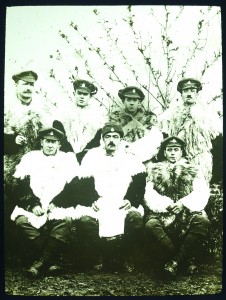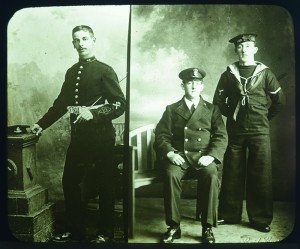Castleton Lanterns community project aims to identify Great War servicemen
Published in Editorial, Issue 4 (July/August 2014), Volume 22Last year Faye Rice, a committee member of Alexandra Presbyterian Church, Belfast, found a box of old lantern-slides in the organ loft of the church. There are 77 slides, consisting of 137 faces of soldiers and sailors in military uniform. Alexandra is made up of the congregations of York Street and Castleton churches. York Street was destroyed during the Belfast Blitz in 1941. While Castleton was severely damaged during the same bombing raid, it was rebuilt and the congregation invited that of York Street to join them, and Alexandra as it is today was formed.
In the minutes of the Castleton committee we found that the slides were made by Belfast photographer Alex R. Hogg, a familiar name owing to the photographs he took for the Belfast Corporation in the early twentieth century. The Ulster Museum’s Hogg collection contains over 6,500 glass plate negatives and lantern-slides and is an important visual resource for the history of late nineteenth- and early twentieth-century Ulster.
The minutes state that Hogg was asked to put together a lantern-slide exhibition of ‘our men at the front’, to be shown on 16 December 1918, not long after Armistice Day. Tickets were sent to the families of serving men, and each family in the parish with a serving son gave a photo for use in this exhibition. We set out to discover who these men were, what they did and, for 31 men, how they died. Armed with the Roll of Honour, photographs of the slides and very little technical knowledge, we set up a website, castletonlanterns.co.uk.
We researched the names on the Roll and, despite the limited information provided, we now know most of the men’s occupations and where they lived, which regiments they were in, the battles they fought and in some cases how they fared after the war. Of the men who are listed as ‘killed in action’, most died in July 1916, a defining year for Ireland as a whole. The most popular regiment was the Royal Irish Rifles, with many men enlisting in the 15th (North Belfast) battalion and the 14th (Young Citizen Volunteers) battalion. The Royal Navy was also a favourite with the Castleton men, many of them in service with the Navy before war broke out. A close third was the Royal Engineers, in which my own great-great-uncle served and was killed.
The most difficult part of the project is matching the names of the men on the Roll to the faces on the slides. Many of the men who died had their photographs printed in local newspapers, aiding identification. Families are coming forward with original images of their relations and have filled in additional information about their lives. We have linked with organisations such as the Red Barn Gallery and the NI War Memorial, which has enabled us to reach out further into the community to find families. Volunteers are involved in the search for original photos and families, and when a face is newly identified we take another step towards our goal—to identify the faces of all these men from this small Belfast parish who volunteered for service.

One of the stories we have been able to tell is that of Lance-Corporal Jack Trimble, Royal Irish Rifles, who enlisted at fifteen, emigrated to Australia and had a family of three sons, eight grandchildren and fifteen great-grandchildren. He told his story to a school group; it was recorded and given to the project by his niece, Bertha McIlroy. The recording outlines his views on battle, on comradeship, on home leave and on how he would ‘do it over again’. He died aged 98. Another is Royal Inniskilling Fusilier Lance-Corporal James McCann, who was killed at the Somme on 1 July 1916. A relative, David Morrow, supplied a letter penned by James’s friend, James Magill, who had written to McCann’s mother, Mary, to tell her how her son had died and that he had received a proper burial. Coincidentally, James Magill is another of the men featured in the slides. Through the project the relatives of these men met for the first time since that letter was written almost a century ago.
It is easy to forget how much these families gave up, how a whole generation of young men was lost and how much the community needs to remember not only the sacrifice of those who died but also the sacrifice of those who lived. The attempt to identify the men is a way of shining a light on their lives. With no surviving veterans of the Great War, it is important that these faces do not become numbers or statistics. These men had names, families, memories and experiences that we hope to record for generations to come.
Karen O’Rawe is Project Manager of the Castleton Lanterns community project, castletonlanterns.co.uk.

















